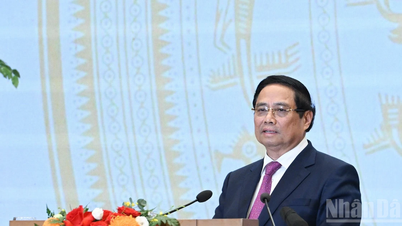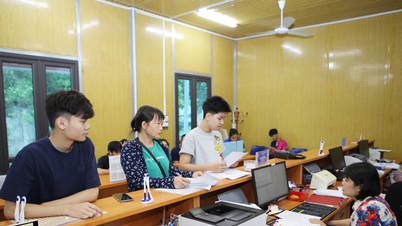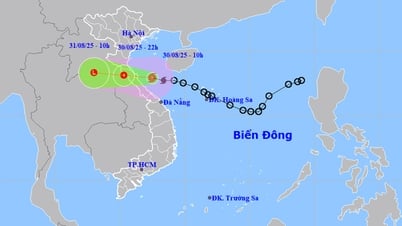This message promotes the reproductive autonomy of adolescents and reflects the close relationship between reproductive rights, gender equity and sustainable development. In Vietnam, this message is materialized through the communication theme “Reproductive autonomy in a changing world ”, which emphasizes the role of reproductive rights in sustainable development and improving population quality.
Mr. Nguyen Van Hung and his wife happily welcomed their first child - the first "snake baby" of the year of the Snake, at Hanoi Obstetrics Hospital (2025). Photo: Khanh Hoa/VNA
Reproductive rights in a changing world
World Population Day was initiated by the United Nations Development Programme (UNDP) in 1989, after the global population reached the 5 billion mark on July 11, 1987. Since then, July 11 has become an occasion for countries to collectively recognize and evaluate major population-related issues, thereby promoting specific, sustainable actions for the quality of life of people today and future generations. Among these, reproductive rights are one of the consistent contents.
According to the United Nations Population Fund (UNFPA), the current global population is estimated at around 8.2 billion people, with the global population growth rate currently at its lowest level since the 1950s. However, growth is uneven across regions: while Africa has a high birth rate, many countries such as Japan, South Korea, and Germany are facing rapidly aging populations and low birth rates below replacement level.
Alongside demographic change are a host of socio -economic changes. Climate change increases natural disasters, food insecurity and migration; protracted conflict in many places disrupts access to health, education and family planning. Meanwhile, the wealth gap and gender inequality remain major barriers to the reproductive rights of millions of women and girls.
Hundreds of millions of women around the world still lack access to reproductive health care, family planning and the information they need to make informed decisions about whether, when and with whom to have children, the United Nations Population Fund warns. Protecting reproductive rights is not just about providing health services, it is about ensuring that women have choices that are respected and free from coercion.
Vietnam is facing a situation of "declining birth rate, excess males and shortage of females". If the gender imbalance at birth continues at a high level, by 2034, Vietnam will have a surplus of 1.5 million males aged 15-49, and this number will increase to 1.8 million by 2059.
In Vietnam, the population issue is also entering a transition period. With a population of over 101.1 million people, Vietnam ranks 15th in the world in terms of population size. Although the population growth rate has been well controlled for more than three decades, many new challenges are emerging, requiring a shift in focus from “population control” to “improving population quality”.
One of those challenges is the gender imbalance at birth. According to the Department of Population and Labor Statistics (General Statistics Office), in the period 2021-2024, the sex ratio at birth in our country was 109.8 boys/100 girls. In 2024 alone, this ratio was 110.7 boys/100 girls. Some localities even recorded this ratio at nearly 120 boys/100 girls. Gender imbalance affects social structure and family security.
In addition, the high rate of teenage abortions reflects gaps in sex education and reproductive health care for adolescents. Most adolescents do not have sufficient knowledge about safe sex, or do not know where to seek appropriate medical help. In particular, migrant women, self-employed workers, people with disabilities and the poor are groups that may have more difficulty accessing family planning and reproductive health care services.
Protecting reproductive rights - responsibility and action
Protecting reproductive rights is not just about ensuring access to health services, but is an essential part of human rights, linked to gender equality, public health, education, poverty reduction and sustainable development. In a rapidly changing world, the reproductive rights of women and adolescents need to be at the forefront of population and development strategies.
Vietnam is the 3rd most populous country in Southeast Asia (after Indonesia and the Philippines) and the 16th most populous country in the world. After 5 years, from 2019 to present, Vietnam's population has increased by 4.9 million people.
According to the United Nations Population Fund, governments need to take decisive action in five key areas: Ensuring equitable access to reproductive health care and family planning services: especially for women, the poor, people with disabilities and young people in remote areas. Integrating comprehensive sex education into the general education curriculum: helping young people understand and take initiative in reproductive health issues. Promoting gender equality and combating gender stereotypes in society: eliminating male preference, controlling the sex of childbirth, protecting women's right to choose. Strengthening communication and promoting behavioral change in the community: mobilizing the participation of mass organizations, media and social networks. Putting young people at the center of population policy making: encouraging the voices of young people, supporting creative initiatives for reproductive health and gender equality.
In Vietnam, recognizing the challenges in the new period, the Vietnam Population Strategy to 2030 has clearly defined the viewpoint: "Taking people as the center, taking population quality as the goal". To concretize these strategic orientations and implement the goal of Resolution No. 21-NQ/TW on "Maintaining the replacement fertility rate", the Standing Committee of the 15th National Assembly issued Ordinance No. 07/2025/UBTVQH15, amending and supplementing Article 10 of the Population Ordinance. The Ordinance takes effect from June 3, 2025, clearly stipulating the rights and obligations of each couple and individual in implementing family planning and reproductive health care: deciding when to give birth, the number of children and the interval between births in accordance with age, health status, learning conditions, labor, income and child-rearing capacity - on the basis of gender equality and voluntariness.
In fact, communication models and community interventions on population and reproductive health are being deployed more and more widely. Typical examples include youth clubs on reproductive health, the “Teenage Counseling” program in schools, or community communication campaigns in mountainous and disadvantaged areas - where access to health services is still limited. The coordination between the health sector and social organizations has been contributing to spreading the right awareness of reproductive rights, promoting the participation of each citizen in implementing population policies in a proactive and humane manner.
In 2023-2024, the birth rate in Vietnam will begin to show signs of decreasing more rapidly. In 2024, the birth rate in urban areas will decrease to 1.67 children/woman, while in rural areas it will reach 2.08 children/woman. The Ministry of Health predicts that the birth rate will continue to decrease in the following years.
The 2025 Population Communication Plan issued by the Ministry of Health has chosen the theme “Reproductive Self-Determination in a Changing World” as the overarching direction, with many communication, education and social mobilization activities being implemented in provinces and cities across the country. The activities are required to be implemented practically, effectively, and reach many classes of people, especially youth, women and people in disadvantaged areas.
The Population Department has put forward a number of key propaganda slogans such as: “Giving birth is a right - Raising good children is a responsibility”; “No teenage pregnancy for your own health, future and happiness”; “No early marriage, no incestuous marriage to protect the race”; “Healthy population - Happy family - Prosperous country”… These slogans not only contribute to raising awareness, but also convey the strategic orientation: taking people as the center, improving population quality, building healthy - happy - responsible families, thereby contributing to realizing the country's sustainable development goals.
According to baotintuc.vn
Source: https://baolaocai.vn/quyen-sinh-san-trong-mot-the-gioi-nhieu-bien-dong-toan-canh-va-goc-nhin-viet-nam-post648428.html









![[Photo] People eagerly lined up to receive special publications of Nhan Dan Newspaper](https://vphoto.vietnam.vn/thumb/1200x675/vietnam/resource/IMAGE/2025/8/30/53437c4c70834dacab351b96e943ec5c)






































































































Comment (0)